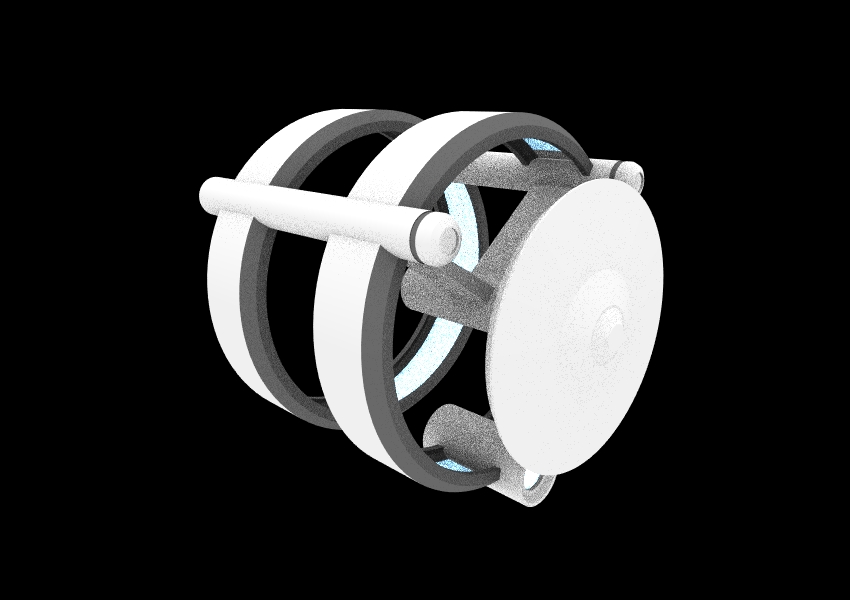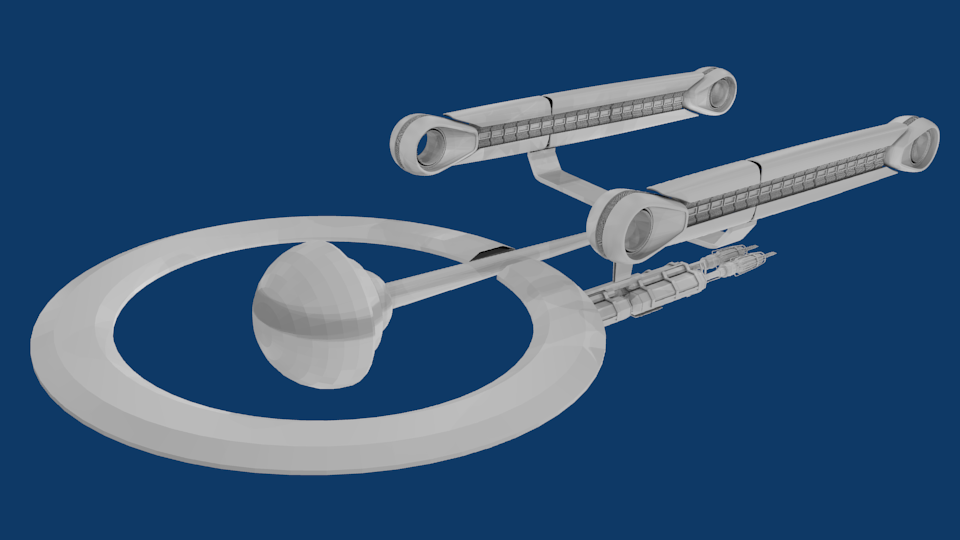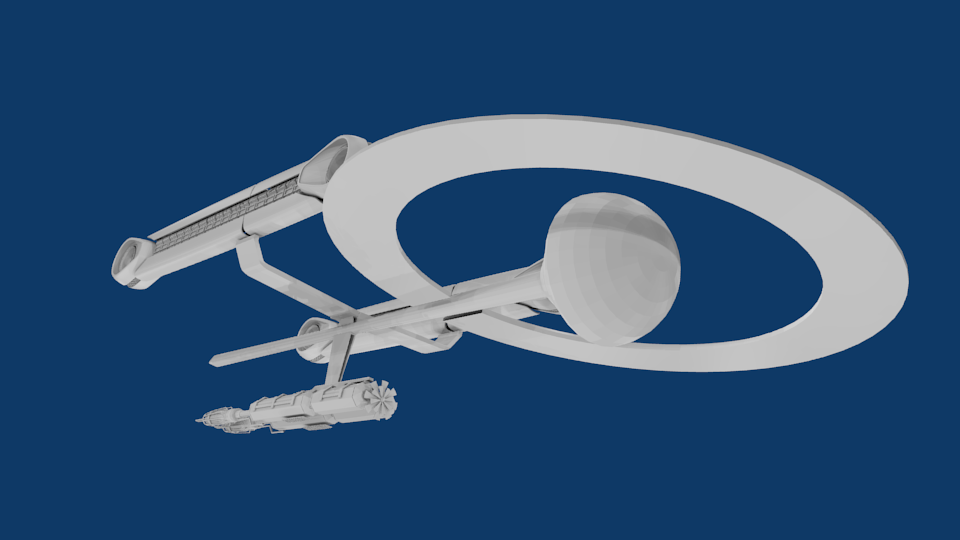^Um, vaguely, but then, if you did that, it would be something else.
-
Welcome! The TrekBBS is the number one place to chat about Star Trek with like-minded fans.
If you are not already a member then please register an account and join in the discussion!
You are using an out of date browser. It may not display this or other websites correctly.
You should upgrade or use an alternative browser.
You should upgrade or use an alternative browser.
Imagine the Enterprise, over again!
- Thread starter MadMan1701A
- Start date
True, but would that cause enough acceleration to really bother anyone in the ship, as long as the artificial gravity is working?It's the wrong generation, and it might not be quite what you mean, but your description keeps making me think of Atolm's Chariot Class, Christopher.
No, that's not it at all.
I just had a thought. If we're using a space warp alcubierre drive, do you even get traditional acceleration anyway? Maybe the inertial dampneners aren't even necessary, if the drive is inertial less anyway. Just a thought.
Well, you'd still need some form of conventional thrust to start yourself in the right direction before engaging warp, and for orbital maneuvering, docking, etc.
I'm still thinking, but I have an idea now.
-Ricky
I just don't think that orienting a spaceship's gravity vector with its thrust vector is something that needs to be justified while orienting it perpendicularly is the default. If anything, it's the other way around. It stands to reason that a spacefaring civilization would most likely spend centuries traveling in ships before they invented some kind of artificial gravity field, so there'd be a well-established tradition of ships designed with their gravity vectors either rearward due to thrust or radially outward due to rotation. And the designers of AG-equipped spaceships would most likely continue that established spacegoing tradition, instead of reverting to the orientation of ground or sea vehicles. If any ship designer did design a ship with a single shipwide gravity vector perpendicular to the direction of thrust, it would probably be seen as an atavistic affectation, tantamount to designing a jet plane to look like a trireme.
So when a fictional ship is designed that way, to me it just trumpets the fact that it was designed by an Earthbound creator from the 20th/21st century, because only someone raised with Earthbound assumptions and little experience with actual space vehicles would see that as the default. And that undermines the illusion that it's the creation of an advanced starfaring civilization.
Years ago, I came up with a design idea for a type of FTL drive that formed a cylindrical core at the center of the ship. This type of drive, as a side effect, would "leak" gravitons and thus draw things toward it, and the makers of the ships would use this side effect as the basis of the shipboard gravity -- the vessels were cylindrical and the gravity vector was inward toward the central axis, the inverse of what you'd get from a rotating centrifuge. So wherever you stood on the ship, the floors would curve downward from you to port and starboard, and the lower decks would have stronger gravity than the higher ones, by the inverse square of the distance.
So when a fictional ship is designed that way, to me it just trumpets the fact that it was designed by an Earthbound creator from the 20th/21st century, because only someone raised with Earthbound assumptions and little experience with actual space vehicles would see that as the default. And that undermines the illusion that it's the creation of an advanced starfaring civilization.
Years ago, I came up with a design idea for a type of FTL drive that formed a cylindrical core at the center of the ship. This type of drive, as a side effect, would "leak" gravitons and thus draw things toward it, and the makers of the ships would use this side effect as the basis of the shipboard gravity -- the vessels were cylindrical and the gravity vector was inward toward the central axis, the inverse of what you'd get from a rotating centrifuge. So wherever you stood on the ship, the floors would curve downward from you to port and starboard, and the lower decks would have stronger gravity than the higher ones, by the inverse square of the distance.
Years ago, I came up with a design idea for a type of FTL drive that formed a cylindrical core at the center of the ship. This type of drive, as a side effect, would "leak" gravitons and thus draw things toward it, and the makers of the ships would use this side effect as the basis of the shipboard gravity -- the vessels were cylindrical and the gravity vector was inward toward the central axis, the inverse of what you'd get from a rotating centrifuge. So wherever you stood on the ship, the floors would curve downward from you to port and starboard, and the lower decks would have stronger gravity than the higher ones, by the inverse square of the distance.
So the decks were arrranged like the growth rings of a tree?
Sounds similar to H. Beam Piper's globular ships which had decks laid out like the layers of an onion with a ag source at the core.
Hello everyone,
I'm just dropping in to post a link I found at Crowlspace:
http://www.sciencedirect.com/science/article/pii/S2211379713000041
It's a paper on artificial gravity fields for spacecraft (and no, I don't really understand it ). I admit that building one is still quite a long way off, but it's not impossible that if there's ever a starship, it could have artificial gravity. How it would be oriented is anyone's guess though.
). I admit that building one is still quite a long way off, but it's not impossible that if there's ever a starship, it could have artificial gravity. How it would be oriented is anyone's guess though.
Timon
I'm just dropping in to post a link I found at Crowlspace:
http://www.sciencedirect.com/science/article/pii/S2211379713000041
It's a paper on artificial gravity fields for spacecraft (and no, I don't really understand it
 ). I admit that building one is still quite a long way off, but it's not impossible that if there's ever a starship, it could have artificial gravity. How it would be oriented is anyone's guess though.
). I admit that building one is still quite a long way off, but it's not impossible that if there's ever a starship, it could have artificial gravity. How it would be oriented is anyone's guess though.Timon
So the decks were arrranged like the growth rings of a tree?
Basically, yeah. Although I did a later version where the inhabited portions were a set of toroidal rings set apart from the central core, with the assumption that the gravity next to the core would be very strong and you'd need to be at some distance to have Earthlike gravity. Sort of like DS9's habitat ring vis-a-vis the station core, but with gravity pulling toward the axis.
I like the arrangement, but it doesn't feel right. 
Most Sci-Fi ships nowadays look either like spaceplanes, or long cylinders, so I want to stay away from that... if TOS hadn't existed, the basic shape of the 1701 would still be unique now, wouldn't it?
Still working on my idea... it's not coming out of my head onto paper or into Blender right.
-Ricky

Most Sci-Fi ships nowadays look either like spaceplanes, or long cylinders, so I want to stay away from that... if TOS hadn't existed, the basic shape of the 1701 would still be unique now, wouldn't it?
Still working on my idea... it's not coming out of my head onto paper or into Blender right.

-Ricky
Taking some of the ideas here...
How about this? Something similar to the original, but with more "modern" sensibility.

Stand it on its tail end and it looks like a stool. Sorry.

Well, I like it. The saucer is there, a primary hull, the nacelles and struts, possible elements of an Alcubierre drive... Give it a splash of color and some surface details and I'll take her around the block, see how she handles.Taking some of the ideas here...
How about this? Something similar to the original, but with more "modern" sensibility.

Stand it on its tail end and it looks like a stool. Sorry.

Yeah, those kind of designs are arrangements that I've been thinking about and sketching. They're realistic, but still don't feel right.
Keep bringing ideas, guys.
-Ricky
Keep bringing ideas, guys.

-Ricky
Maybe a saucer isn't the way to go, then. One of Jefferies's original designs had a spherical hull, and we've seen this represented in the Daedalus and Olympic-class ships -- not to mention ships in other franchises like the Discovery in 2001. A sphere actually makes a lot more sense for a spacecraft hull than a saucer does, because it's one of the basic stable shapes for a pressurized hull in vacuum, the others being a torus and a cylinder with hemispheric endcaps.
I like your designs, Klaus, but I really think aalenfae's has the potential to be something truly different but still adhering to the requirements for all the parts that need to be there for an Enterprise. Yours kinda make me think of what would happen if you attached a saucer to the front of XCV-330. Sorry.
Hey guys,
Your comments are really got me thinking, that I need to move a lot farther out of the box.
I sketched this out tonight... I think this is what I'm going to go with.
So, the big bulb is the habitable area of the ship. Decks are oriented perpendicular to the direction of travel, as Christopher suggested.
The saucer part is actually what I'm going to call the Electromagnetic Force Field array, which acts basically like a deflector shield. No habitable area in there.
The nacelles of course, made larger, and the matter / antimatter reactors are below.
I also plan to have some fusion rockets at the rear, for backup sub-light, or maneuvering.




This is all really rough, but what do you guys think?
-Ricky
Your comments are really got me thinking, that I need to move a lot farther out of the box.
I sketched this out tonight... I think this is what I'm going to go with.

So, the big bulb is the habitable area of the ship. Decks are oriented perpendicular to the direction of travel, as Christopher suggested.
The saucer part is actually what I'm going to call the Electromagnetic Force Field array, which acts basically like a deflector shield. No habitable area in there.
The nacelles of course, made larger, and the matter / antimatter reactors are below.
I also plan to have some fusion rockets at the rear, for backup sub-light, or maneuvering.




This is all really rough, but what do you guys think?
-Ricky
Very, very nice. 

That looks very interesting. The only suggestion I would have is that in the event of an emergency the pod should be able to separate, but at the moment it would have to dodge the outer ring which might not always be possible.
So, the big bulb is the habitable area of the ship. Decks are oriented perpendicular to the direction of travel, as Christopher suggested.
The saucer part is actually what I'm going to call the Electromagnetic Force Field array, which acts basically like a deflector shield. No habitable area in there.
Interesting. It makes sense to have the habitable section encased within a shield array like that. It differentiates nicely between the habitat section, which needs protection, and the uninhabited engine section. Indeed, perhaps the shield would be a defense against radiation from the engines themselves as well as from cosmic radiation/debris. (Although a EM shield would only protect against particle radiation, not gamma/x-rays.)
Along those lines, how about some shielding domes on the front of the engine nacelles to protect the habitat section? Might evoke the forward domes of the classic design a bit. Also, if the gravity vector is now "rearward," then there's no real reason to have the nacelles oriented "straight up" as they are -- it's a little incongruous. How about angling them radially outward from the center line, at 120-degree angles from each other and the reactor assembly? (Although I can't help thinking it would be more symmetrical if you had three nacelles 120 degrees apart and the reactor assembly along the centerline. Certainly if you had fusion rockets, they'd need to be at the centerline or the thrust would be imbalanced.)
In this design, the habitat section seems rather small, unless it's a really huge ship. Maybe it could be a bit bigger, although I like the idea of the majority of the ship's mass/volume being uninhabited and devoted to engines and shielding.
That looks very interesting. The only suggestion I would have is that in the event of an emergency the pod should be able to separate, but at the moment it would have to dodge the outer ring which might not always be possible.
Not necessarily. If the ring is the shield that protects the crew, then it should stay with the habitat sphere when it separates from the engines. So the separation point should be just behind where the ring meets the connective strut to the engines.
Similar threads
- Replies
- 2
- Views
- 1K
- Replies
- 133
- Views
- 7K
- Replies
- 26
- Views
- 1K
- Replies
- 1
- Views
- 212
If you are not already a member then please register an account and join in the discussion!


